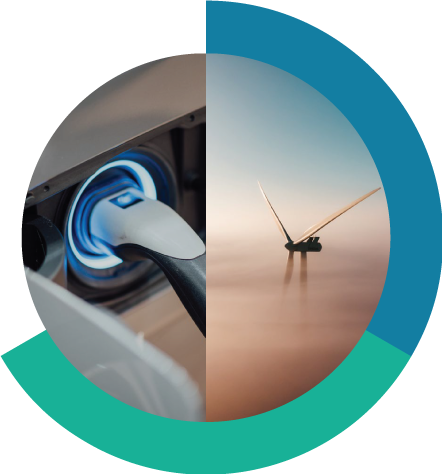
Page TItle
Nine ways a circular economy can help avert the climate crisis
New research ‘Circular Economy as a Climate Strategy’ outlines current understanding of how a circular economy can help avert the climate crisis. It outlines nine calls-to-action decision makers and researchers can take to maximise circular economy benefits in order to help limit warming to 1.5 ̊C and avoid the worst impacts of climate change.
DOWNLOAD PAPERListen to the authors, Dr Ke Wang, Dr Patrick Schröder and Dr Garvin Heath discuss the paper’s findings in WRI’s Big Ideas into Action Podcast:
How can a
circular economy help
avert the climate
crisis?
Reducing
greenhouse gas emissions
Half the global emissions come from the extraction and processing of materials.
Circular economy strategies reduce the demand for raw materials and new products, therefore reducing emissions from production. While recycling is often the first circular economy strategy thought of, it is the more ‘upstream’ strategies, such as shifting consumption patterns and material-efficient product design that will deliver the highest emission reduction potential.
Global greenhouse gas emissions per sector in 2019.
Source: IPCC 2022
The built environment, transport, and the food system offer the highest potential to reduce emissions through circular economy strategies.
Materials-related and operational energy use emissions by
sector.
Sources: Built environment: Global Alliance for Buildings and Construction et al. 2019. Transport: IPCC 2022; Hertwich et al. 2019, with extrapolation by authors. Food system: IPCC 2019. Plastics:OECD 2022. Textiles: McKinsey and Global Fashion Agenda 2020. Electronics: Belkhir and Elmeligi 2018, with extrapolation by authors. Materials-related and operational energy use emissions by sector.
Supporting the clean energy transition
The transition to clean energy such as solar and wind power, and electric vehicles, is a prominent part of global climate action to reduce emissions.
Producing more wind turbines, solar panels and electric vehicles will require a much larger supply of minerals, potentially by a factor of 20 or more for lithium, cobalt, and nickel, and decommissioned clean energy equipment will soon become a fast-growing new waste stream, if not properly managed.
Circular economy strategies can support a more sustainable scaling of the clean energy transition by relieving material supply pressure, increasing supply chain resilience, preventing new waste challenges, accelerating the adoption of clean energy technologies, all while maximising climate benefits.

Material-efficient product design and manufacturing.
For example, the development of low-cobalt or cobalt-free cathodes in electric vehicle batteries can reduce minerals, while reducing the socio-ecological costs and carbon footprint.

Extending a product’s life.
As clean energy equipment is material and energy-intensive to manufacture, there is greater climate benefit to keep the equipment in use for longer through upgrade, repair, refurbish and remanufacture, than early replacement with newer technologies.
Adapting to climate change
Ninety percent of terrestrial biodiversity loss and water stress are caused by material resource extraction and processing. As we are already witnessing and experiencing the impact of the climate crisis, enhancing adaptation to climate change is as important as mitigation.



What COP parties
have circular economy
strategies
in their
climate plans?
There has been increasing momentum to call on policy makers to include circular economy approaches in national climate plans. While the number of COP parties mentioning circular economy or equivalent strategies has increased from 2015 to 2022, many focus only on waste management and some of the largest emitters have not yet considered this approach. Where waste management has an important role to play in emissions reduction, more systemic strategies are needed to deliver the highest emission reduction potential.
Current COP parties with circular or equivalent strategies mentioned in national climate pledges.
Note: based on 2022 data. Source: This map was made using the keyword search functionality on WRI’s Climate Watch. Keywords used: circular, recycling, resource efficient, and resource efficiency. Each mention of ‘circular’ was checked manually and only those that referenced a circular economy were included. Each mention was also scanned to determine whether systemic, upstream circular economy strategies areincluded. The NDCs that have not yet been added to Climate Watch were searched manually using the same methodology as above.
What action do we need to maximise circular economy climate benefits?
Building on the literature- and consultation-based knowledge landscape, the following nine interconnected areas are identified for collective action:

1. Shift consumption patterns.

2. Stimulate product circularity from the design phase.

3. Incorporate circularity across clean energy value chains.

4. Integrate circular economy strategies into national climate policies and plans.

5. Incentivise cross-border greenhouse gas emission reductions.

6. Connect circular economy metrics with climate change impacts.

7. Increase transparency and comparability in modelling methodologies.

8. Apply systemic and context-specific impact assessment to inform decision-making.

9. Investigate the role of the circular economy in climate change adaptation.
We invite governments, businesses, philanthropies, NGOs, multilaterals and researchers to join the discussion and act collaboratively towards the nine actions outlined in order to accelerate the transition to a circular economy and deliver widespread climate benefits. This will help shift us onto a pathway to limiting warming by 1.5°C to help avert the climate crisis and avoid its most devastating impacts.
DOWNLOAD PAPER

